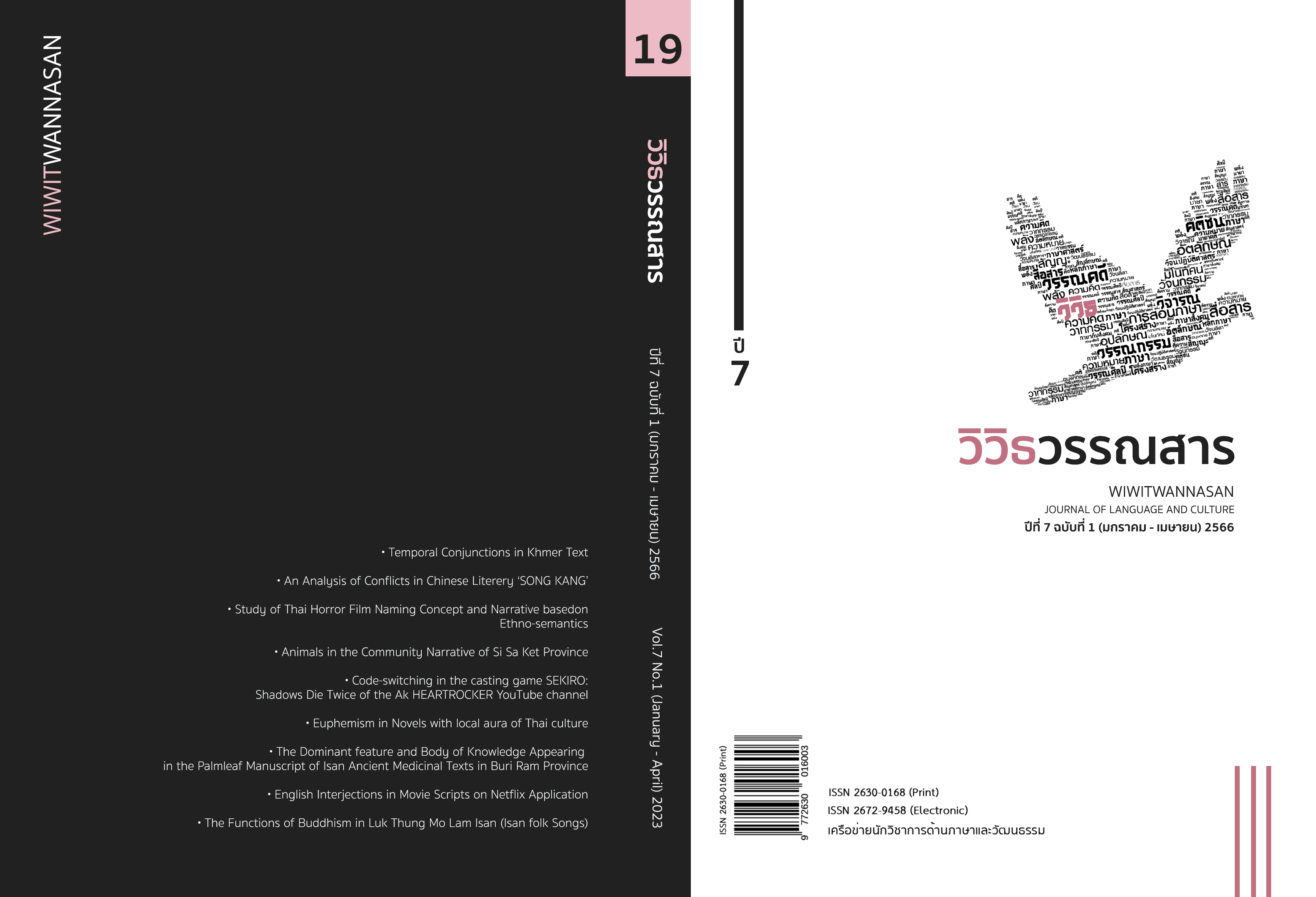สัตว์ในเรื่องเล่าของชุมชนจังหวัดศรีสะเกษ
Main Article Content
บทคัดย่อ
บทความวิจัย สัตว์ในเรื่องเล่าของชุมชนจังหวัดศรีสะเกษ มีวัตถุประสงค์เพื่อศึกษาเรื่องเล่าของชุมชนในจังหวัดศรีสะเกษ โดยใช้วิธีศึกษาด้วยระเบียบวิธีวิจัยเชิงคุณภาพ ใช้ข้อมูลที่ได้จากการสัมภาษณ์ภาคสนามโดยเลือกแบบเจาะจงพร้อมกับการศึกษาเอกสารในด้านคติชนวิทยา นำเสนอข้อมูลที่ได้จากการวิเคราะห์เกี่ยวข้องกับสัตว์ในชุมชน 11 ชุมชน ซึ่งเป็นชุมชนที่พบเรื่องเล่าเกี่ยวกับสัตว์ที่สื่อความหมายศักดิ์สิทธิ์และมีความสำคัญกับชุมชนในด้านวัฒนธรรม ได้แก่ 1) บ้านคอนกาม ตำบลคอนกาม อำเภอยางชุมน้อย 2) บ้านห้วยตึ๊กชู ตำบลห้วยตึ๊กชู อำเภอภูสิงห์ 3) บ้านหนองงูเหลือม ตำบลหนองงูเหลือม อำเภอเบญจลักษ์ 4) บ้านจาน ตำบลจาน อำเภอกันทรารมย์ 5) บ้านคำเมย ตำบลคำเนียม อำเภอกันทรารมย์ 6) บ้านผือใหม่ ตำบลเมือง อำเภอกันทรลักษ์ 7) บ้านขมิ้น ตำบลแขม อำเภออุทุมพรพิสัย 8) บ้านเหล่าเสน ตำบลบก อำเภอโนนคูณ 9) บ้านหนองมะเกลือ ตำบลโนนค้อ อำเภอโนนคูณ 10) บ้านหนองนกเจ่า ตำบลรังแร้ง อำเภออุทุมพรพิสัย และ 11) บ้านสำโรงพลัน ตำบลสำโรงพลัน อำเภอไพรบึง ผลการศึกษา พบว่าชุมชนดังกล่าวมีเรื่องเล่าที่เกี่ยวกับแมลง สัตว์เลื้อยคลาน สัตว์เลี้ยงลูกด้วยนม และสัตว์ปีก เรื่องเล่าที่พบมีความเชื่อมโยงกับนัยของความเชื่อที่สะท้อนอัตลักษณ์ เป็นวัฒนธรรมชุมชนที่เกี่ยวกับความความทรงจำ บุคคลสำคัญ ธรรมชาติ และสิ่งเหนือธรรมชาติของชุมชน อีกทั้งยังมีความสัมพันธ์ระหว่างกลุ่มชาติพันธุ์กับวิถีชีวิต และความเป็นอยู่ รวมถึงภูมิปัญญาของชาวบ้านในชุมชน
Article Details

อนุญาตภายใต้เงื่อนไข Creative Commons Attribution-NonCommercial-NoDerivatives 4.0 International License.
ลิขสิทธิ์ของบทความเป็นของวารสาร การพิมพ์ซ้ำจะต้องได้ร้บการอนุญาตจากบรรณาธิการวารสาร
เอกสารอ้างอิง
Aungthongkamnerd, C. (2019). Rakhine Folk Tales: Function of Recording the Social and Lifestyle Aspects of Rakhine People. The Golden Teak: Humanity and Social Science Journal (GTHJ.), 25 (3), 15-27.
Boonsong, B. (2013). Mythologies: Principles in the World of Maya. Journal of Humanities (Naresuan University), 10 (2), 1-10.
Charoenwong, P., & Khemnak, P. (1987). Take a Tour of Cave Art Pha Taem Khong Chiam. Silpakorn Journal, 3 (12), 4-31.
Chaiklam, S. (2020). The Roles and Upakkilesa in the Lower Northern Folk Tales. Journal of Humanities and Social Sciences Mahasarakham University. 39 (6), 115-127.
Hongsuwan, P. (2006). The role of "Dogs" in the myths and rituals of various ethnicities in Southeast Asia. Journal of Letters, 35 (2), 213-241.
Kawi, R. (2015). Tale Myth Toponymy and History: Function Value and Identity of Thaphapum Community in Maelanoi, MAEHONGSON Province. [Master’s Thesis, Chiang Mai Rajabhat University]. Graduate School Rajabhat Chiang Mai University. http://www.graduate.cmru.ac.th/core/km_file/345.pdf
Khemnak, P. et al. (1989). Rock art of the historic period in Pha Taem Khong Chiam. Office of Archaeology Fine Arts Department.
Lakul, A., & Tularak, U. (2017). Tale Type and White Animal’s Motifs In Ruined City Legends of North Eastern Region. Journal of Language, Religion and Culture. 6 (2), 37-50.
Maneerat, P. (1982). Anthropology and Folklore Studies. Thammasat University Press.
Marknuan, P. (2013). The Role and Transmission of Magic and Rituak in Folk Healers at Ban Nong Khai Changwat Kanchanaburi [Master’s Thesis, Chulalongkorn University]. Chulalongkorn University Intellectual Repository (CUIR). http://cuir.car.chula.ac.th/handle/123456789/42820
Nathalang, S. (2003). Folklore Theories A methodology for analyzing legends and folktales. Faculty of Arts Chulalongkorn University.
Nillakarn, L. (2018). Belief culture with the faith management of the community. Narkbhut Paritat Journal Nakhon Si Thammarat Rajabhat University. 10 (2), 11-20.
Ongkeaw, W. (2010). Auspicious and unlucky beliefs about plants and animals of the villagers, Singhanakhon District, Songkhla Province [Master’s Thesis]. Taksin University.
Pattanathanapha, J. et al. (2018). Naga Beliefs in Isan: Buddhist and Brahmanical. Lecture notes in The 14th International Conference on Humanities and Social Sciences (IC-HUSO) 2018. (pp. 942-952). Khon Kaen University.
Phrakruchiratummathat. (2014). Study of the relationship between the Chao Mae Song Nang ritual and supporting social ethics community on the bank of the Mekong River Nong Khai Province. Mahachulalongkornrajavidyalaya University.
Phonkaewket, A. (2019). A Study of Matters and Roles of Ancestor Spirit in Selaphum district, Roi Et Province. Dhammathas Academic Journal. 19 (4), 1-12.
Sangkaphanthanon, T., & Sangkaphanthanon L. (2018). Green Folklore: Folklore studies, in the View of Ecocriticism. Journal of Social Sciences and Humanities Research in Asia (JSHRA), 243 (1), 3-30.
Singlumpong, O. (2018). The comparison of female representation between Chinese movie "The sorcerer and the white snake" and Thai movie "Maebia". Apheit Journal. 24 (2), 109-118.
Sindhuprama, S. et al. (2012). Tales of change Field-notes at Ban Kong, Po Karen, Lao Wiang and Lao Kang, Uthai Thani Province. Journal of Sociology and Anthropology. 31 (2), 191-202.
Srisuchat, A. (1989). Rock art of the historic period in Kanchanaburi. Office of Archaeology Fine Arts Department.
Sriton, A., & Tularak, U. (2021, March 25). Sacred Water and Cultural Communication of Phu Wiang Mountain Community, Wiang Kao, Khon Kaen. Lecture notes in The 22nd National Graduate Research Conference. Khon Kaen University. (pp. 753-765).
Tanta-Ariya, S. (2018). Processes for Tourism Management by the Folklore of the community [Doctoral dissertation, Silpakorn University]. DSpace Silpakorn University. http://ithesis-ir.su.ac.th/dspace/bitstream/123456789/2385/1/56251802.pdf
Tandikul, N. (2018, November 16). mysterious animals and why to kill them. The Momentum. https://themomentum.co/mysterious-animals-and-why-to-kill-them/
Tarachai, P. (2020). Conservation management of Nature Birds. [Unpublished manuscript]. Faculty of Animal Science and Technology, MAEJO University.
Thongkaw, S., et al. (2018). Tuat spiritual beliefs that influence local culture [Grant]. Department of Cultural Promotion.
Vechasat, K. (1991). The Mythical Swan in Thai Art. Bangkok: Silpakorn University Research and Development Institute.
Winithasathitkul, P., & Phramahachirachant. (2015). Folklore: Beliefs in Thai Society.Journal of MCU Humanities Review, 1 (1), 31-44.
Wisudthiluck, S. (2017). Animal kingdom: Anthropology of animals and animal studies.Kobfai.
Wongprom, P., & Rojanawong, N. (2019). Insects of Life: Learning Ways from Thung Kula to Community Forest. Foundation of Rural Youth.
Wongthes, S. (2000). Naga in the history of Southeast Asia. Matichon.
Wongthes, S. (2016, May 30). Dogs are the ancestors who gave birth to people in the Ban Chiang culture 3,000 years ago. Matichon Online.https://www.matichon.co.th/columnists/news_154206


